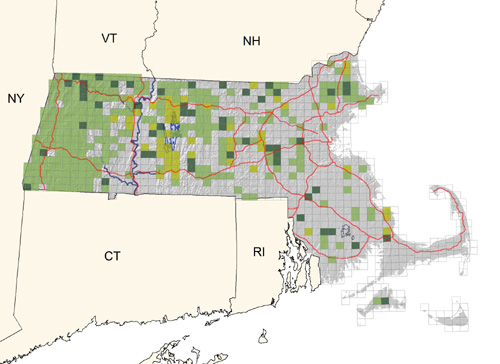Find a Bird - BBA1
Breeding Bird Atlas 1 Species Accounts
Black-throated Green Warbler
Dendroica virens
Egg Dates
May 21 to August 6
Number of Broods
one; occasionally two

As with many forest species, on a statewide basis the Black-throated Green Warbler is probably no more uncommon now than it was in presettlement times, due to the extensive reforestation that has taken place since the 1880s. In proper habitat, it is not at all difficult to find. It is most prevalent in the northern hardwood-hemlock forest of Berkshire County, less common in the White Pine-hemlock-oak forests of Worcester County and northeastern sections, and locally distributed in the Red Maple-Atlantic White Cedar swamps of the southeastern portion of the state.
Black-throated Green Warblers are a conspicuous and relatively common migrant throughout Massachusetts. The first wave of spring arrivals usually occurs in the first week of May, although individuals rarely may appear as early as mid-April. Migration usually ceases by the end of May. Unlike many other wood-warblers, whose voices are less distinct and memorable, the Black-throated Green Warbler sings a song that is instantly recognizable by its vocal quality as well as by its pattern. When this warbler is heard in early May, it heightens the senses, for it is immediately evident that, if a wave of warblers has arrived, spring is truly here.
Males establish territories with much singing and excited chipping, sometimes chasing and fighting for possession of an area. The songs are of two types and are used in different contexts. One type is zee-zee-zoo-zoo-zee, the third and fourth notes lower in pitch. The alternate song seems to be uttered with a quicker tempo, zee-zee-zee-zee-zee-zoo-zee. Slight emphasis is placed on the fifth note. The dreamy, lispy quality is unmistakable, and, to quote Maine pioneer ornithologist Cordelia Stanwood, “His voice is suggestive of the drowsy summer days, the languor of the breeze dreamily swaying the pines, spruces, firs, and hemlocks.” The common call notes are a chet, similar to that of the Black-and-White Warbler, and a lisping tsip.
Breeding pairs prefer to place their nests in White Pine or Eastern Hemlock, but there is considerable individual variation as to tree species, nest height and location, and materials used. A nest in Rehoboth was placed 8 inches above the ground in a Red Cedar (ACB), but they are generally located higher and may be 50 to 70 feet up. On Martha’s Vineyard, a nest was discovered at 8 feet in a whorl of small branches in a Pitch Pine. The nest was the typical cup constructed of grass, seaweed, and bark lined with fine grasses, cow hair, horsehair, and feathers (ACB). In Pelham, several nests were located in Eastern Hemlock, including one 15 feet up and 6 feet from the trunk and one 30 feet up and 15 feet from the trunk (Nice 1932). A nest in West Brookfield was constructed about 60 feet high in a large White Pine (Meservey). In Winchendon, 1 nest was located in a spruce sapling, 1 in a spruce at 12 feet high and 10 feet from the trunk, and 2 against an Eastern Hemlock trunk at 12 feet and 15 feet, respectively (Brewster 1888).
Four to five eggs constitute a typical clutch, which is incubated mostly by the female for about 12 days. Clutch sizes for 7 state nests were as follows: three eggs (1 nest), four eggs (5 nests), five eggs (1 nest) (ACB, Brewster 1888, DKW). The Martha’s Vineyard nest contained four fresh eggs on June 8 (ACB). The period from hatching to fledging is the easiest time to confirm breeding because adults are continuously foraging and returning to the nest to feed the young, with males usually, but not always, assisting in this care. Food consists of insects, including caterpillars, larvae, and beetles gleaned from foliage and occasionally on the wing. Known state hatch dates are July 10, July 11, and August 6 (Nice 1932). The young fledge at 8 to 10 days of age. Nestlings have been reported in the state from June 12 to August 13 (Brewster 1888, Nice 1932, Meservey). State dates for nest departure are July 19, July 20, July 25, August 13, and August 14, with the young being 8 or 9 days old (Nice 1932, 1933). Brood sizes were two young (1 nest), three young (1 nest), four young (2 nests) (Brewster 1888, Nice 1932). Pairs and single adults feeding fledglings have been observed in Massachusetts from July 6 to September 7 (Nice 1936, Meservey).
Although much literature reports that this species is not double brooded, there is evidence that some pairs do in fact raise two sets of young. Nice (1932) observed that the prolonged song period of the male (into August) and the late dates for fledglings were highly suggestive that two broods may be reared. Similar impressions were obtained in portions of Worcester County in more recent years, where birds have also been recorded feeding young in September; and one male was observed alternately feeding nestlings and a large fledgling (Meservey). None of these behaviors is typical for a single-brooded warbler species. Further observa-tions of color-marked individuals would be desirable.
Young birds gain strength and improve feeding efficiency during the late summer. At this time a molt occurs, complete in the adults and partial (body feathers) in the young. As in other wood-warblers, considerable wandering occurs during this season, bringing individuals into areas not normally frequented by the species. Fall migration is underway by late August, peaks at the end of September, and generally ends by late October. Stragglers have been found as late as mid-December, but there is no record of overwintering. The wintering grounds extend from Texas and Florida through Mexico to Panama and the Greater Antilles.
Map Legend and Data Summary
Atlas 1 data collected from 1975-1979


Note: fairly common in coniferous and mixed woodlands in hill country; less common eastward
Bruce A. Sorrie



